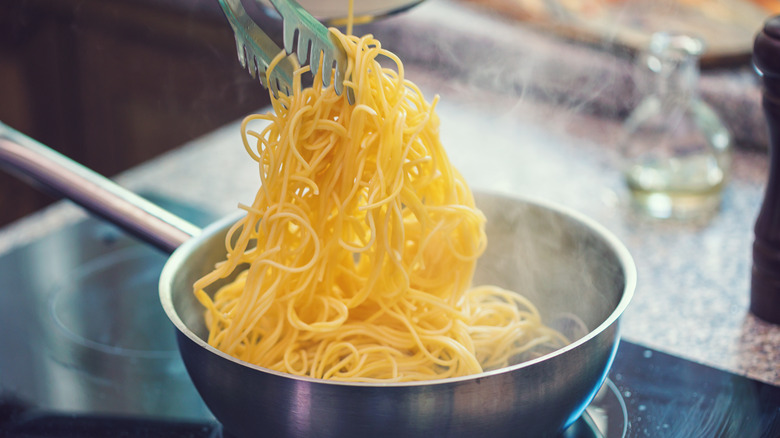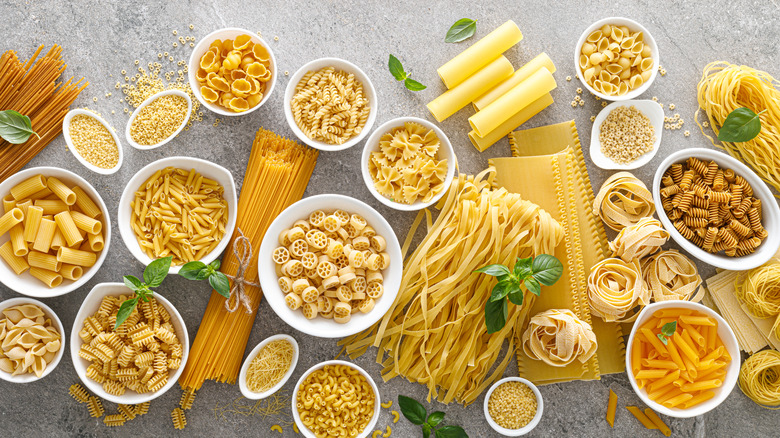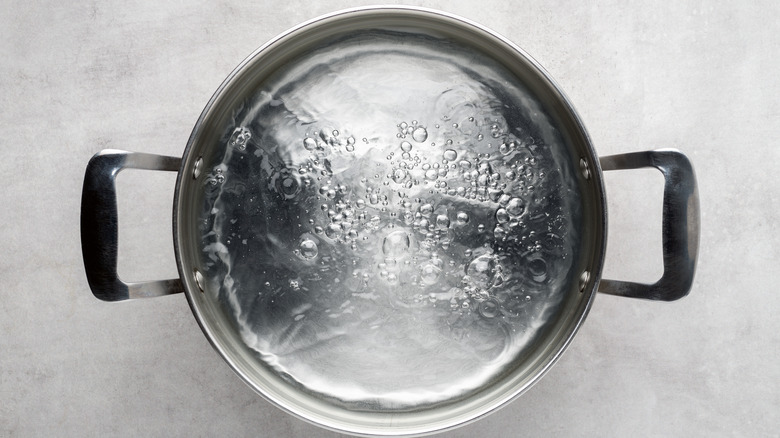The Simple Water Hack For Easily Reheating Leftover Pasta
Dried pasta doubles in size when it boils, which could be why it seems like there's always some spaghetti or rotini left over. Even though all store-bought pasta comes with cooking instructions on the box, it's easy to just fill a pot with water and dump in an eyeballed portion of dried pasta. A little extra farfalle or cavatelli isn't a bad thing, though. There are tons of ways to use up leftover noodles, and most kinds of pasta keep well in the refrigerator.
The trouble often comes in when it's time to reheat the pasta. If you're about to put a bowl of last night's noodles into the microwave, slow your roll. Microwaves are great for quickly heating up a lot of different leftovers, but plain, cold pasta isn't one of them. What you need is a pot of boiling water.
When pasta cools down in the refrigerator overnight, the starches congeal and get very sticky. If you use a microwave to heat it up, you'll only make it sticker, and dryer. If you give your leftover pasta a quick dip in some boiling water, however, it'll be just as good as the day you made it.
It's all about the starch
We've all probably had pasta that was warmed up in the microwave. Although it's not terrible, it's also not great. If you're heating up a quick lunch of leftovers at work, the microwave might have to suffice. Any other time, however, you should consider using a boiling water bath to reheat your leftover pasta.
When dried pasta is boiled, the starch molecules expand and gelatinize, and some of the starch dissolves in the pasta water. This makes space in the noodles for water to be absorbed, which is how the noodles get soft from boiling, and also how the pieces expand. When the noodles are cooled down, the cooked starch contracts, congeals, and loses moisture. When the noodles are warmed up in a microwave, they lose even more moisture, which typically makes pasta chewy. If you quickly boil the pasta to reheat it, however, the congealed starch will expand again and the noodles will reabsorb water, giving the pasta the right texture.
Don't choose the microwave just because you think it's faster, either. You don't need to boil your cold pasta for very long. Drop your cold noodles into the pot and let them bubble for 30 to 60 seconds and then drain them away from the water, and they'll be ready to serve.
Reheat pasta like the pros
Flash-boiling cold pasta is so effective that it's actually a common technique used in commercial kitchens. Unless the dish is made with fresh pasta, which only takes a few minutes to cook, most pasta made in restaurants is parboiled ahead of time and then heated to order in a pot of boiling water. In many restaurant kitchens where pasta is made to order, there's a line cook whose job is to make the pasta dishes as they're ordered, and all service long, they dip wire baskets filled with handfuls of pasta in and out of the boiling water as the orders come in. You can easily do exactly the same thing at home using a fine mesh sieve with a handle to dip your pasta or invest in a stainless steel "spider," which is just a flat wire basket with a handle.
Now that you know you can reheat pasta without sacrificing texture and quality, you don't have to worry about making too much rigatoni next time. In fact, you can boil a big batch of pasta one night and save some of the cooked noodles in the fridge for prepping easy weeknight dinners. All you have to do is flash it in boiling water, and boom — dinner's ready.


